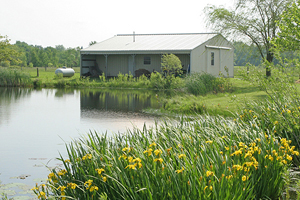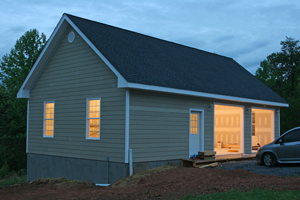
My wife and I have just bought a block and will be building a new house – as part of this will be the building of the “shed” – which is really a workshop as I am a very keen Woodworker (I have most of the toys!!). My question is – Leaving money aside “Is a brick or metal shed better – especially in regards to moisture, inside temperature (heating and cooling), noise etc”? Any other suggestions would also be appreciated – eg lining the structure, power needs, lighting, etc. I appreciate your expert opinion. – Ivan Banks
Chris Marshall: You’re asking a question that would take many magazine articles or a whole chapter of a good shop-design book to answer adequately. If you haven’t already done so, you might also want to ask this question to the good folks that frequent our forum on woodworking.com. Every woodworker with a shop will have a slightly different answer, so here’s mine. I’ve never had a brick shop, but my last one was a metal pole barn (30 ft. x 40 ft.). I outfitted the interior with 2×6-framed walls and plenty of insulation. It stayed reasonably cool in the summer and warm in the winter, using a wall air conditioner and a 60,000 BTU furnace. Currently, I have a 24 ft. x 42 ft. garage space for my shop. It is framed conventionally with 2×6 walls and stick-built 2×10 rafters. I’ve only been in my new shop for about a year, but it is working just as well or better than my pole barn did, because the new shop has many large windows that let in lots more natural light. I’ve used 8-ft. fluorescent T8 light fixtures in both buildings with good success, and I ran both 110- and 220-volt outlets all around the room. The last shop had a plywood floor; the current one, a concrete slab. I thought I would notice a bigger difference between the two flooring types, in terms of how tired it makes my legs by the end of the day. But in all honesty, a good pair of supportive shoes seems to make the difference moot for me. Both types of buildings benefit from a dehumidifier during humid months (when I’m not running the A/C, that is) to keep the relative humidity low and my tools rust-free. If all things were equal, and money were no object, I would probably go with a conventionally framed wood building over the pole barn. It was easier to build that from scratch as opposed to retrofitting the pole barn framing with walls afterward. But, as I say, the next woodworker will probably offer you a completely different answer from mine. Good luck in your decision!

Tim Inman: You don’t say where you will be located, but if you are anywhere that gets cold I definitely have a suggestion. I’ve built three shop buildings over my years. In each one, I’ve put down 2-inch closed cell foam board underneath six inches of concrete for the floor. I would never build a shop — or anything else, for that matter — without this. The foam lets the concrete become a huge heat sink and warming stone. My feet are never ever cold when I work on this combination. The shop stays reasonably warm without spikes in the heat and cooling. The tools are more rust-free, and I like it.
Other than that, you can’t have too much light — especially north light! — and you want accommodations for all the electricity you can imagine. Ceiling fans are a must. A good dust collection system is good, too. Don’t forget to plumb in for compressed air. Do NOT use hard PVC water pipe for compressed air — ever. If/when it breaks or ruptures, it explodes into tiny sharp glass-like shards. I know firsthand. I’ll tell you about it some other time. Think balloon popping!





